Understanding Coated Glass: Types, Benefits, and Applications for Energy-Efficient Buildings

Coated glass is crucial in modern construction, particularly in building façades. It offers numerous benefits, such as improved energy efficiency, solar control, and aesthetic versatility. Let’s break down the fundamentals of coated glass in a simple, easy-to-understand manner for those unfamiliar with the subject, and understand the types and benefits
What is Coated Glass?
Coated glass is simply glass that has been treated with a thin layer of material, usually metals or metal oxides, to enhance its performance. The coating alters how the glass interacts with sunlight, heat, and external environmental factors. There are two main types of coatings: hard coatings and soft coatings.

Hard Coatings vs. Soft Coatings
Hard Coatings:
- Production: These coatings are applied while the glass is still hot, during its production. This process is called pyrolytic coating, where a vapor of metal or metal oxide fuses to the hot glass surface.
- Durability: Hard coatings are more durable because the coating is fused to the glass. It can handle physical wear and tear better than soft coatings.
- Performance: While durable, hard coatings tend to have slightly lower performance in terms of energy efficiency and solar control compared to soft coatings. However, they are long-lasting and easier to handle.
Soft Coatings:
- Production: These are applied after the glass has been produced, in a vacuum chamber, through a process called sputtering. Multiple thin layers can be added, allowing for greater control over the coating’s thickness and performance.
- Performance: Soft coatings offer higher performance in terms of heat insulation (low emissivity) and solar control. However, they are more delicate and can be damaged by abrasion or moisture.
- Durability: Since soft coatings are not fused to the glass, they require protection. These coatings are typically used in Insulated Glass Units (IGUs) to protect them from external wear.
How Do These Coatings Work?
- Solar Control: Both types of coatings can reflect or absorb solar radiation, helping to reduce the amount of heat that enters a building. This keeps interiors cooler in hot weather, reducing the need for air conditioning.
- Low Emissivity (Low-E): This refers to the glass’s ability to reduce the transfer of heat. Low-E coatings help keep heat inside the building during winter, improving energy efficiency.
- Optical Clarity: Coatings also impact the amount of light that passes through the glass, affecting how much natural light enters the building and the visual clarity from inside.
Applications of Coated Glass
- Energy Efficiency: Coated glass is widely used in windows and façades to improve energy efficiency by minimizing heat loss in winter and heat gain in summer. This can significantly reduce energy costs for heating and cooling.
- Aesthetic Flexibility: With coatings, glass can be tinted or made reflective, offering architects the flexibility to create visually striking buildings.
- Comfort and Functionality: It helps maintain comfortable indoor temperatures and reduces glare, making indoor spaces more pleasant for occupants.
Key Benefits of Coated Glass
- Energy Savings: Reduces heating and cooling costs by improving thermal insulation and controlling solar heat.
- Aesthetic Versatility: Available in various colors and reflective finishes, making it suitable for both functional and decorative purposes.
- Durability: Hard coatings are long-lasting, while soft coatings offer higher performance when protected within insulated glass units.
Common Issues and Considerations
- Hard Coatings: Can sometimes cause a slight haze or color variation in certain lighting conditions due to imperfections in the coating thickness.
- Soft Coatings: Require careful handling and protection because they are more prone to damage and need to be sealed within an IGU to maintain their high performance.
Final Thoughts
Coated glass is essential in modern architecture, especially in energy-efficient and sustainable building designs. While hard coatings offer durability, soft coatings provide superior performance but require more care. Understanding these basics can help you appreciate the role of coated glass in creating comfortable, visually appealing, and environmentally friendly buildings.
Want to learn more about coated glass, its types and benefits? Contact us.


Comments are closed.